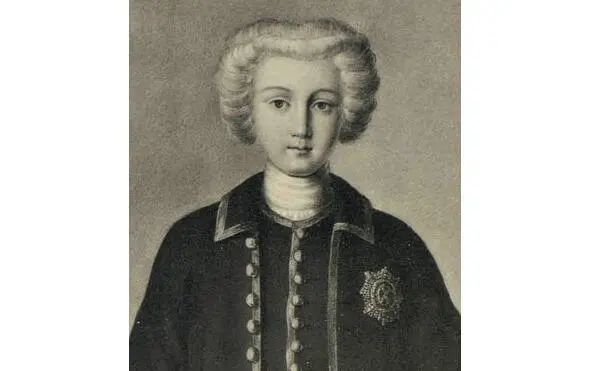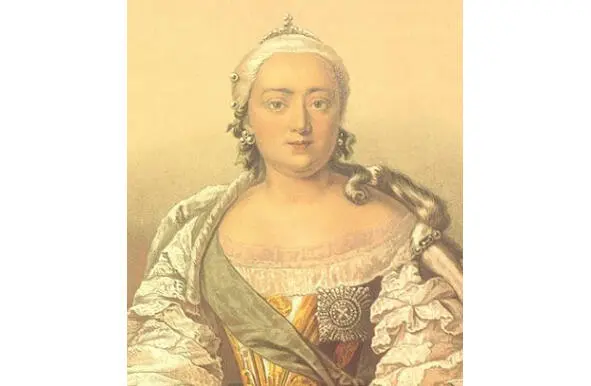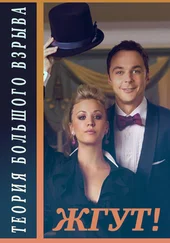Peter begins to think about a successor. He and his brother Ivan the Fifth have no more sons. The new decree, allowing the monarch to appoint any person, including a woman, as heir to the throne himself, causes some ferment in society. In the same 1724, the tsar’s kidney stone disease was aggravated. Catherine is suspected of adultery. Her candidacy for a high post is being questioned.
In February 1725 Peter the Great dies.
For two years Catherine the First (Skavronskaya), the king’s widow, has ruled. She exhausts her strength at balls and feasts, and in 1727 she leaves the sublunary world.
The last representative of the Romanovs in a straight line, eleven-year-old Pyotr Alekseevich, the son of Tsarevich Alexei who died in prison, ascends the throne. Almost immediately A. Menshikov, the «semi-sovereign ruler,» betrothed him to his 16-year-old daughter Maria.
The new rulers, not lovers of hasty changes, are moving the capital back to Moscow. The military fleet is in decline. The boyars and the Supreme Privy Council rule, and not an heir, prone to wine since childhood. Locally and centrally, the nobles do whatever comes to their mind.

Peter II (1715 – 1730), son of Tsarevich Alexei Petrovich and German princess Sophia-Charlotte. He ascends to the throne at the age of eleven, studies hardly an hour a day, does not show interest in state affairs, kills thousands of rabbits while hunting, dies at fourteen.
In 1730, Peter II died of hypothermia and fever, which complicated the disease with smallpox. This actually ends the Romanov dynasty.
At the Privy Council, the Dolgoruky presents a forged testament to the emperor; to give the rights to the throne to the bride of Peter II, Ekaterina Dolgoruka. The powerful Golitsyns make their competitors laugh. Anna Ioannovna, daughter of Peter the Great’s brother, Ivan the Fifth, widow of the Duke of Courland, becomes Empress.
In 1735, another war starts with Turkey and the Crimean Khanate. The Russian army captures Azov and Ochakov. With an interval of a year or two, three trips to the Crimea are carried out. The army even reaches Bakhchisarai, the capital of the khanate, but returns due to lack of food and water. The cholera epidemic that broke out in 1736 reduces a significant part of the army, as well as the entire population of the peninsula. The European allies are withdrawing from the war. According to the Belgrade Peace Treaty of 1737, Russia loses all conquests, except for Azov, subject to the tearing down of its fortifications. Exit to the Black Sea and trade are allowed exclusively on Turkish ships.
Laughing at the Dolgoruky, trying to make the monarchy manageable, the Golitsyn brothers fall into disgrace on charges of high treason.

Anna Ioannovna (1693 – 1740), Russian empress, fourth daughter of Ivan the Fifth and Tsarina Praskovya Fyodorovna.
In 1740 Anna Ioannovna dies from an attack of urolithiasis. According to the will, the son of the empress’s sister, two-month-old Ioann Antonovich, becomes the emperor. With the regency of the mother and the supervision of Biron, the baby rules the year. Further, to the throne, with the help of the Guards of the Preobrazhensky regiment, who do not want to fight in cold Finland against the Swedes, Elizaveta Petrovna, the daughter of Peter the Great, who was born before the tsar married Catherine Skavronskaya, rises to the throne. All portraits, church books, passports, coins with the image of the juvenile king are confiscated. Ivan the Sixth together with his parents goes to the Shlisselburg Fortress. Here he, playing with spiders and rats, is kept in solitary confinement, out of communication with people.
In 1741, Sweden, not yet realizing that it had entered the category of militarily second-rate European powers, wishing to return the Northern Territories, declared war on Russia. The main actions take place all in the same Finland. A year after her accession to the throne, Elizabeth inclines the people of these lands to the side of Russia. The main carrot is the possibility of creating your own state. The forces of the parties are approximately equal. The losses are also about the same. The Russian army 10,500 people, the Swedish – 12,000. In the end, the Swedish army capitulates, goes home, leaving the Russian artillery.
In 1757, as part of a broad coalition, Russia launched military operations against Prussia. The reason is the illegal annexation of Saxony. Together with the Austrian troops, during the Battle of Kunersdorf, she manages to defeat the army of Frederick II. Of the 48 thousand soldiers, according to the German monarch himself, only 3 thousand remain alive. But the allies get entangled in orders and, instead of an immediate march on Berlin, disperse. Presumably, this «miracle» is associated with Catherine-Friderica, the future empress and her entourage – the commander-in-chief Apraksin and Chancellor Bestuzhev, who are playing their secret game at the court of Elizabeth. The second «miracle of the Brandenburg House», which Adolf Hitler hoped for a third time later, will take place in January 1762. Peter III, who ascended the throne, an ethnic German, a fanatical admirer of Frederick II, will break the treaty with Austria without explanation and conclude a separate peace.

Elizaveta Petrovna (1709 – 1761), the youngest daughter of Peter the Great and Catherine. The Empress gives rise to Gallomania. Since childhood, dreaming of becoming related to the Bourbons, she diligently studies French. Elizabeth is in a secret church marriage with Alexei Razumovsky. For a child born in this marriage, Princess Tarakanova (self-name – Elizaveta Vladimirskaya) posed herself or appeared to be one.
In 1761, the childless and unmarried Elizabeth dies of an undiagnosed illness after a sudden throat bleeding. She is inherited by the grandson of Peter the Great, the son of his daughter Anna from his second marriage and the Duke of Holstein, the Holstein-Gottorp (German) ducal dynasty. Actually, according to the dynastic rules of inheritance, Anna joins this clan. Her children can no longer be «Romanovs» at all. But, in the conditions of a political crisis, this trifle is not paid attention. The main thing now is at least a bit of «royal» blood.
So, Karl Peter Ulrich, aka Peter the Third Fedorovich, occupies the Russian throne. The health and upbringing of the boy is affected by the fact that at one time the prince was flogged with rods, put his knees on peas, and subjected to more sophisticated tortures. The young man seems to be inclined to military affairs. However, he attaches importance not to the maneuvers and material support of the army, but to drill and parades. At the age of 17, already at the Russian court, Peter was married to Sophia Frederick Augusta, a native of the German city of Stettin, the future Catherine II. The dignitaries even assign mentors to the couple of monarchs – an exemplary married couple. But, it doesn’t help much. Instead of fulfilling the duties assigned to her husband, according to contemporaries, in the evenings the prince plays with the tin soldiers. Peter is unpleasantly surprised when, in 1754, Catherine still gives birth to his son Paul (the future emperor). However, the emotional attachment between the spouses remains.
Under Peter III, some sensible laws begin to work, but these are, rather, the homework of influential nobles. The monarch’s own initiative is the return of East Prussia, which has been part of the Russian Empire for four years, to its former owner, beloved Emperor Frederick II. Not quite fulfilled idea – reduction of church property, abolition of monastic land tenure, ban on icons. The third remarkable idea of the native of Holstein is a dynastic war with Denmark, a long-time ally of Russia, for the Schleswig (territory in the south of Denmark) taken from the German ancestors of Peter III.
Читать дальше















